The XVII — XVIII centuries is the time when France begins to play a fundamental role in the development of dance and dance genres, a powerful absolutist state that has become one of the centers of the spiritual life of Western Europe. In the field of choreographic art, its influence extends primarily to everyday dance: most of the dance genres and forms popular in this era are of French origin; Italy, on the other hand, is losing the status of a country dictating a dance fashion throughout Europe. It should be noted that for high-class French society, dance is becoming one of the main attractions: balls with their splendor and luxury are a favorite pastime of the nobility, including the king himself. But nevertheless, the functions of the dance are much wider than simple entertainment: it is both a means of communication and a way to solve a variety of (up to state) issues; the dance penetrates even the music of the church rite. Not without reason, the German composer Matteson, without disturbing the religious feelings of those around him, was able to create a suite from the tunes of a number of choirs containing a minuet, gavotte, sarabanda, burr and polonaise. Dance rhythms are saturated with the song of court life, which often bore the name "chanson a danser" in France. Eloquent evidence of the attitude of the French towards dance and dance music can serve as a statement reached by one of our contemporaries, who, according to his own formulation, loved to "fall asleep to the sounds of anlemand and wake up to the sounds of a jig."
Such an atmosphere of social life creates favorable conditions for the development in France of not only everyday dance and its many forms and genres, but also stage dance. This was reflected, first of all, in the formation and further development of the classical ballet performance, which originated in the art of Italy at the end of the 16th century. Being at first essentially a simple divertissement in which music, word and dance are still in synthetic unity, and the choreography prevails over the dramatic content, the court ballet is gradually filled with greater semantic significance and in the XVIII century it turns into a one-piece play with developed dramaturgy embodied by pantomime and dance.
It is noteworthy that the dance genres common in everyday life and used in stage works, in their choreography and musical accompaniment, did not differ much from each other. In theatrical performances they perform the same dances as at the balls, regardless of the plot of the performance, its internal dramaturgy. In the 1st half of the 17th century, in France, mainly in Paris, Italian dances still continue to be danced - pavana, galliard, etc. In addition, French varieties of some Italian dances come into fashion and then become famous throughout Europe (for example, chimes , volts). Many common dances, previously considered obscene or extremely rude, are spreading in high society (saraband, chacon, etc.), but are radically transformed in accordance with the tastes of the nobility.
At the same time, various folk branles penetrate Paris from the French provinces, which become the source of new court dances (minuet, burr, gavotte, etc.). Naturally, all the folklore, life-realistic elements are excluded from them, only the scheme of the gallant, erotically colored game remains. Thus, in addition to dances of ceremonial exits and processions, on the one hand, and dances of a more lively character, even more or less connected with the traditions of peasant dance, there are dances of a proportionate, symmetrical and artfully stylized movement.
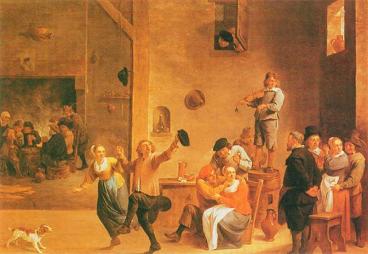 |
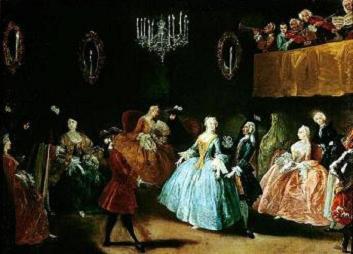 |
By the end of the XVII century, many mass dances, common earlier (pavana, galliard, volta, etc.), are gradually forgotten. Such popularity as allemanda, burr, gigue, chimes, lur, minuet, paspier, ribodon, sarabanda, forlana and others are gaining popularity. In most of them, the democratic principle of the round dance movement is rejected. Now pairs of dancers form a column; their places are strictly regulated depending on the class-hierarchical relationships of the participants.
At the beginning of the 18th century, pair dances dominate: bourrée, paspier, rigodon, gavotte and minuet, whose movements and music are distinguished by their striving for the strict beauty of forms, clarity, elegance and sophistication of expression. But by the middle of the century, despite the luxury and splendor inherent in court balls, dances with their complex etiquette were replaced by dance forms that were close and accessible to wide public circles. Pair dances give way to mass, primarily polonaise and counter-dance. The spread of counter-dance and its many varieties is greatly facilitated by the new norms of social behavior, which abolish the construction of couples according to the court ceremonial and consolidate some freedom and immediacy in the performance of the dance.
The Great French Revolution (1789 - 1794) played an important role in the development of everyday dance genres, during which dance, song and music became an indispensable attribute of numerous folk festivals. Often, dances in the streets and squares become round dance, truly massive; it is not by chance that such an ancient genre as farandola is being revived.
At the same time, among the third estate, pair dances are coming into fashion, involving close contact of partners. The most popular dance of this kind is the waltz, which originates from the popular Austro-German Deutsche and Landler. At the end of the 18th century, the waltz is just beginning its triumphal procession. Considered at first obscene, it is subjected to persecution, prohibitions, which only contributes to its widespread distribution.
An important place dance and its diverse genre varieties occupy in the works of composers of the XVII-XVIII centuries. Perhaps, all the authors of this era (from Lully to Mozart and Beethoven) pay close attention to popular dances in everyday life. Creating works directly for performance in ballrooms (often simple and uncomplicated), they at the same time saturate non-dancing vocal and instrumental music with dance rhythms. The rhythmic and melodic turns of many dances penetrate the numerous organ, orchestral, instrumental compositions of Baroque composers (Bach, Handel, Telemann), and their oratory. The dance is the genre basis of the compositions of the French harpsichordists (Chambonier, Cooperin, Rameau and others) and the English virginalists (Bird, Bull, Gibbons and others). Intonations and rhythms of dance permeated the work of composers of the Viennese classical school; The especially organizing role of dance and rhythm is manifested in the large instrumental forms of the Viennese classics, primarily in the symphony.
|
Thus, the tradition of the indirect implementation of dance genres in instrumental music, which originated in the Renaissance, in the XVII-XVIII centuries, is further developed. The metric base is increasingly complicated by melodic decorations, figures, harmonic color, as a result of which the dance pieces of many composers finally lose touch with their everyday source. They do not have a formal reflection of the nature of the dance movement, but its idealization and creation on this basis of deep ideological and emotional images. But despite the apparent simplicity of the musical language of everyday dances and the complexity and richness of their highly artistic samples, the dance music of the XVII-XVIII centuries as a whole is characterized by clarity and distinctness of the structure, periodic dissection of melodic phrases, regular metric accents, and features of even greater clarity and certainty. |
 |
The process of development of the melodious melody of a wide breath, which manifested itself in the Renaissance, continues. As a result, we can say that the basic qualities of dance music by the end of the 18th century are finally crystallizing.
Allemanda
Courant
Sarabanda
Gigue
Welt
Send your good work in the knowledge base is simple. Use the form below
Students, graduate students, young scientists who use the knowledge base in their studies and work will be very grateful to you.
Posted on http://www.allbest.ru/
Introduction
Dance is the oldest and richest type of art: a very interesting, multifaceted, vibrant, carrying a huge emotional charge. Folk dance is the ancestor of all areas of dance, which were formed over many centuries on its basis, it is classical, and historical, everyday, and pop, and modern dance. Fashion and the passage of time could not affect it, and there it was more forced to completely disappear from the face of the Earth, because it carries the history of the people who created it. Each generation sacredly keeps the memory of their ancestors and cherishes everything that reflects their life.
In this regard, folk dance has become an invaluable treasure, showing life, basic activities, traditions, events taking place in people's lives. Learning folk dance, we travel the planet. Thanks to this type of art, one can visit any corner of the world, get acquainted with the history of this region, learn the national features of this territory, and for this it is not necessary to cross the ocean to overcome great distances. Many people have dedicated their lives to the study of folk dance. Many books have been written about their discoveries.
Having been engaged in folk dance for more than one year, I often ask myself the question: “What is included in the concept of“ dance ”? Maybe it's just a set of movements or something more? ”To this question I will try to find the answer in several sources.
1. Russian dance as an artistic whole
1.1 General characteristics and scheme of genres
Dance is a bright, colorful creation of the people, which is an emotional, artistic, specific reflection of its centuries-old, diverse life. He embodied the creative imagination of people, the depth of their feelings. Folk dance always has a clear theme and idea - it is always informative. There is a dramatic basis and plot in it, there are generalized and specific artistic images created through a variety of plastic movements, spatial drawings (constructions).
The dance image is perceived both directly and through associations. The truthfulness, concreteness and artistry of dance images is determined by their content and dance vocabulary, organic connection with the melody, its character, rhythm and pace.
Dance in a specific artistic form expresses and reveals the spiritual life of the people, their way of life, aesthetic tastes and ideals. During the development of society, folk dance acquired a greater independent significance, became one of the forms of aesthetic education. The people created dances of amazing beauty and design with diverse contents. Colorful round dances, tricky quadrille, virtuoso, chaste dances of soloists, dashing dance and so on speak about the richness and great variety of Russian folk dance. It has its own original, clear, historically established features, its deep national roots and rich centuries-old performing traditions. This is an independent, original, highly artistic form of creativity of the Russian people. In ancient times, the dance had a religious - magical meaning and was performed with a specific purpose on holidays. Over time, he lost his religious traits and turned into a household dance expressing the feelings and mood of the performer. The duty to perform the dance at certain times of the year was also violated.
The connection of Russian folk dance with specific rites was characteristic of round dances, games and few types of dance. The quadrille, dance, or solo dance were not associated with rituals.
Russian folk dance in each region is distinguished by its vocabulary, receptions, manner and style of performance, the developed bright, intricate rings, expressive positions and weave of hands in combination with a clear rhythm, an original pattern, the source of which can serve everything that surrounds us (nature, work , everyday life, products of artistic creativity - dishes, clothes, lace, etc.)
Russian folk dances are classified not by season, place of performance and occasion, but by their choreographic structure and general stable characteristics. Here is some of them.
Style - characteristic features and properties (features) of expressive means that qualitatively distinguish one dance from another.
Dance vocabulary is the most important expressive tool in dance. Gestures, facial expressions, postures, movements of the hands, head, body, legs - its components.
In Russian folk dance, vocabulary is the most concentrated form with a pronounced national flavor, so it can be determined by which region, region, village, district the dance belongs to. There are several types of dance vocabulary:
1. Shaped - creates an association with a certain way (goose, deer, swan, etc.). She is called emotionally imitative.
2. Naturally - plastic - prompted by the action itself, developing in the dance.
3. Traditional - developed over the centuries, in constant development, as evidenced by dances created today, which differ from ancient dances not only in expressiveness, manner of performance, but also in wealth dance moves.
Intonation is a combination of expressive means. For example, the same movement, performed at a different pace, will express the dancer’s different state: fast pace - joy, slow pace - sadness, thoughtfulness. The slightest change in one or another movement will change the nature and content of the action.
1.2 Music and costume as integral parts of the whole
Music is the soul of dance. She is one of his expressive means, reflects temperament, sense of rhythm, national features and features of its creator (people). Folk music is full of energy, inner strength, spirit and enthusiasm, in slow dances it is distinguished by expressiveness and melodiousness. For a long time in folk life, dances were associated with songs and performed under them. But gradually dances began to appear, performed only to music.
Since each folk dance has many options, the music also changes from dance to dance. Traditional folk melodies are based on a two- and three-part metric structure. In each dance, the music should correspond to the plot, drawing, vocabulary and costume.
Costume and folk dance are constantly dependent on each other. A costume is not only an external form of dance, it is organically connected with its content, it is its “calling card”. In numerous versions of the folk costume there is a lot in common, this gives it a national character, therefore, when designing a stage costume, it is necessary to take into account the characteristic features of the dance and people (choice of fabric, ornaments, decoration, decoration, cut). A randomly selected costume that is not typical for a given region, melody, rhythm and movements significantly reduces the persuasiveness of the production. Russian folk clothes used in dance are diverse, and have a high artistic taste.
The festive men's costume was more stable and the same in the old and new varieties, it has very slight changes in the regions. As a rule, this is a white shirt made from homespun canvas or silk with embroidery characteristic of each region, blue striped ports or a Christmas tree, boots, a long cossack without a collar, and later a jacket, vest. In some areas, a hat sometimes wraps up the costume.
Festive women's clothing is divided into two complexes: the northern one - sarafan and the southern one - worn, and each of them, in turn, is made up of girls and women, the clothes of wealthy peasants and the poor. In the north, both girls and women wore a sundress, and in the south the sundress was mostly girl’s clothes (married women did not wear clothes). Inside these two main groups, the clothes had their own characteristics of cut, color, pattern, not only in each province, but also in individual counties. villages.
Let us cite an example of two types of Russian women's costume: northern and southern. They can be used for staging the dances described in the application.
North Russian women's costume on the example of the Arkhangelsk region
The North Russian women's costume consists of a shirt and a sundress. The shirt could have been embroidered in red, or in smooth white from a cambric or cambric. Its cut is the same for all Great Russians and is sewn from straight canvas panels with not cut armholes. Rectangular pieces of fabric are inserted on the shoulders - polykami, and under the armpits, for free movement of the hand, square gussets. Polyk and gussets were often made from kumach. The square hole formed by the upper edges of the front and back shirts of the shirt and the side edges of the polikes are gathered at the neck in thick assemblies and sheathed with a narrow strip of fabric.
In each district, costumes differ in color, material, cut, but the general, which is characteristic of the North, is a long sundress. The festive summer girl’s costume, which is widespread in the Leshukonsky, Mezensky, Pinezhsky districts of the Arkhangelsk region, consists of a long damask blue sarafan - “damask”, on top of which it is worn “short” (brocade sleeveless man). On the head there is a “bandage” - a half-window or a small window. This is a tall hat without a bottom, consisting of two strips of gown with a bottom of chopped mother of pearl, tied at the back with ribbons. The costume is complemented by a white lace kerchief, an amber or mother of pearl necklace and mother of pearl earrings.
In the Pinezhsky district, several (at least three) large scarves, which, as a rule, were on the shoulders, were punched over the “koroten”, and their ends were slaughtered. “Korotena” at the fishes in the Mezen district is sewn “flared” in the form of a sun, but on Pinega it is only slightly flared and is called a “short fur coat”. In the Karpogolsky district, the region is a crimson sundress, sewn from silk and decorated with gold lace in front. The short murmur on the long straps here is called the "feather". Instead of a “bandage”, a tall kokoshnik - “crown” sparkles on his head, humiliated with white beads and colored glass imitating precious stones. On the neck - beaded beads on a ribbon. In the Shenkur district, the sundress is blue, of printed fabric - “stuffing”, decorated with silver gimbal. There is no murderer, on his head a high, crescent-laced “crown”, embroidered with beads, glass beads and decorated with foil. Amber beads and earrings complement the festive costume.
Southern women's costume on the example of the Kursk region
The main common costume in the Kursk region is a long sundress, most often plain, from woolen or homespun fabric, or from chintz, or from satin, mostly scarlet. The sundress was finished either with brocade or silk ribbons and wide belts. A “curtain” is put on the sundress - an apron made of colored smooth silk or homespun fabric. Under a sundress, a jacket of checkered or white fabric is worn. On top of the sweatshirt are many rows of multi-colored beads and necklaces of river pearls, and often amber.
A colorful and intricate women's headdress consists of a kokoshnik and a slap sewn from brocade. Kokoshnik is tied with a colored silk scarf. On the sides of the kokoshnik flowers are attached, often paper, peacock feathers, sometimes painted feather grass or oats. On top of the kokoshnik, in front, a large bow of colored silk ribbon is sewn. Sometimes a rich hat was replaced with a woolen or silk colorful scarf.
In each district, city or village of the Kursk region, the costume has its own characteristics, its differences in details, in tailoring, color, and embroidery. So, in the south of the region, in Sudzhensky, Oboyansk regions, it has brighter colors than in the north, in Kastornaya or in Fatezh, where the tones of sundresses are more strict, uniform.
Of course, the folk costume in modern processing is sewn from lighter fabrics, for fast, rhythmic dances, shortened sundresses are used, but the cut, color features, the shape of the headdress, embroidery remain unchanged today. Without them, the dance loses its meaning and idea, which were laid in it many centuries ago.
2. The main genres of Russian folk dance
2.1 Round dance
One of the main genres of Russian folk dance is a round dance. This is not only the most common, but also the most ancient type of Russian dance. It is no coincidence that the main construction of the round dance - the circle, its circular composition - the likeness of the sun, walking after the sun - “salting” originate from ancient pagan rites and games of the Slavs who worshiped powerful god of the sun - Yarile.
Round dance participants sing, move, dance and act out. Dance, dance, play and song in a round dance are inextricably and organically linked, and the round dance unites and collects a large number of participants. In distant pagan times, this genre of Russian folk dance was of a cult-ritual nature, but gradually it loses its significance as a pagan-cult action. Round dances with new songs appear. Which reflect social, domestic and other topics.
A round dance is a Russian household dance, it has its own forms and rules of performance, certain relationships between participants, subordinate to known and developed material. It turns into an independent genre and becomes an ornament of holidays of the Russian people. A round dance always shows a sense of unity, friendship, camaraderie. Its participants, as a rule, hold hands, sometimes with one finger - the little finger, often for a scarf, shawl, belt, wreath. All these connections, and, consequently, the constructions depend on the locality in which the round dance is performed, what is its content and to which song, fast or slow, it is performed.
A round dance is widespread throughout Russia, and each region brings in something of its own, creating diversity in style, composition, character and manner of performance. Any round dance figure can have more than one unique, definite and permanent purpose. Without changing the construction of the figure and figure, the participants of the round dance could convey different content and mood. For example, a circle is an image of the sun, worship of a deity - Yarila, but action with labor, love and other themes can be played out in a circular construction. The action of the participants, the expression of their character, mood, temperament, attitude to what is happening are completely different, and the circle as a figure remains unchanged. There are two types of round dance - ornamental and play. The main and most frequently used figures of these types of round dances are indicated and described in the appendix.
Ornamental round dances.
If the text of the song that accompanies the round dance does not contain a specific action, a pronounced plot, characters, then the participants of the round dance in rows, rows, braid various figures - ornaments, matching their step with the rhythm of the song, which is only musical accompaniment for performers. Such round dances are called ornamental.
The inextricable connection of folk art with the life of the people, with its songs, games, dances helped to create many drawings - figures of ornamental round dances. Their intricate weave is inspired by the patterns of Russian lace, wood carvers, painters, and vice versa - delicate lace patterns, delicate wood carvings, etc. Sometimes, as if repeating the figures of a round dance. The contents of the songs accompanying the ornamental round dances are most often associated with images of Russian nature, with poetic generalizations, the collective work of the people, their way of life.
The performance of each ornamental round dance among the people, in everyday life, is distinguished by the rigor of forms and a small number of figures. The whole round dance most often consists of several figures that seamlessly transition, shimmer, rearrange from one to another. An example of an ornamental round dance is indicated in the appendix (“Northern round dance with shawls”).
Game dances.
If the song has characters, a game plot, a specific action, then the content of the song is played out in the faces and the performers create various images and characters of the characters using dances, facial expressions, gestures. In front of the viewer is a round dance. In such round dances, which are sometimes called plot ones, the main thing is to play the content of the song - to reveal the plot, to clash the characters and interests of the characters.
Songs, to which the game dances are performed, are called game or round dance - game. Most of the topics for game round dances are contained in them, reflecting the life and life of the people: work processes, love and fairy tales, etc. Unlike ornamental round dances, the drawing is simpler in them, it does not have such a variety of dance figures. Compositionally, these dances are built in a circle, or lines, or in pairs.
We have analyzed the basic, general features of ornamental and playing round dances, which are characteristic of this most ancient and popular dance in Russia. But in different areas there are local characteristics of dance performance associated with natural and climatic conditions, with the specifics of everyday life and work, with the character of a person. These features are manifested both in the composition of the performers (female and mixed dances), and in the rhythm, and in the content of the songs, and, most importantly, in the special manner of performance inherent only in this area.
2.2 Dance
Dance is the most popular and beloved genre of folk dance now. The dances were created under the influence of the surrounding world and the life of the people. People have perfected them for many decades, left only the most valuable in them and brought them to their final form. In ancient times, dances were mostly ceremonial, cultic in nature, but over time, the religious content began to leave the dances, and they acquired a household character. Not one merrymaking, not a single holiday was complete without dancing.
The dance consists of a number of separate movements - elements that differ in a characteristic manner of performance, have a Russian national flavor and reflect individual character traits of a dancing person. In addition, each movement in the dance is filled with meaning, and with the help of plastic, the performer expresses his feelings, reveals the content of the dance, creates one or another artistic image. All performed movements are subordinated to rhythm and tempo, as well as to the nature of the musical and song accompaniment. All movements are connected together by the content and the accompanying melody. Dancing can express various states of a person, but this is, first of all, joy, health, strength, energy output of the performer.
The dance was born in a round dance and broke out of it, breaking the round dance circuit and providing the imagination and individual mastery of the dancing person, complicating the technical basis, creating its own shapes and patterns, replacing the round dance song with a dance and various musical accompaniment.
The performer of Russian dance has very expressive hands, head, shoulders, hips, face, hands, fingers, etc. The dance makes it possible to reveal personal, individual character traits - to show your manner of performance ("trick"). Each performer can show his ingenuity, skill, professionalism in the dance, flaunt a complex, virtuoso knee. Everyone can dance. It differs from the round dance in the richer and more complex vocabulary of dance movements. The dance includes strong technical shots, “rope”, “accordion”, various squats, crackers, crouching, spinning and other knees. In addition to enriching vocabulary, dance provides an opportunity for complexity and diversity of the picture: dashing exits of guys, provocative penetrations of girls, dashes, various transitions, etc. - all this creates new drawings and constructions inherent only in dance.
There are many types of Russian dance. Here are the most common, well-established, having centuries-old performing traditions and firmly entrenched in the life of a Russian person: single (solo) dance, pair dance, dance, mass dance and group traditional dance.
Group traditional dance.
A lot of people can participate in group dance, but more often its composition is limited to a relatively small group of performers. In some cases, the group dance has a constant cast, and if one of the participants is absent, the dance does not work, and it is difficult to introduce a new person to replace the absent one - he can mix up the whole picture. As a rule, group dance has an established structure. She absorbed many figures of round dances, some group dances included fragments of single or double dances, dance. Typical and most frequently used figures of group dances are given in the appendix.
Each region has its own traditional, distinctive dance, and therefore group dances are often called traditional or regional. Despite the mandatory implementation general drawing dances, various transitions, creating an image, etc., group dances give performers the opportunity to show their individual skills as well. In group dances, an element of improvisation is preserved, but to a lesser extent than in individual dance or dance.
Group dances were created on the basis of folk traditions, taking into account the peculiarities of the local manner of performance, customs and carefully passed from generation to generation. Each group dance has its own specific task and its content. For centuries, people deliberately tried not to complicate group dances with too virtuoso movements. This was done in order not to lose behind this virtuosity the main thing - thoughts, ideas. In the end result, all this gave the group dances a long life. An example of group traditional dance is indicated in the appendix (“Tank with Belts”).
Conclusion
dance folk dance dance
If you compare the figured constructions of a round dance and dance, you can find the general and differences.
The basis of the figured dance construction is a circle and a linear construction. They are used both in a round dance and in a dance. Moreover, very often in these genres the figures are mixed, that is, in the dance you can see the main constructions of the round dance and vice versa. This proves the existence of a close relationship between dance and dance.
But, nevertheless, there are differences in the figures of the two main genres. So the construction of round dances very smoothly pass into each other, they seem to flow, overflow. The basis of the composition of this dance is a circle, lines are used less often. The figures of the dances are more clear and concrete, their change is easier to follow, more attention is paid to vocabulary than to figured rearrangements. These differences exist because dance and round dance have different tasks and goals. Each of these genres has its own purpose and content, and its means are used to uncover ideas, one of which is various figures and realignments.
Therefore, for the production of dance, even for the younger groups of children's choreographic studios, one cannot do without two main genres: dance and dance and simple, elementary figures. Such as “circle”, “two circles side by side”, “circle in circle”, “eight”, “crest”, “snail”, “snake”, “column”, “street”, “gate”, etc. For dancing it’s “Shen”, “Asterisk”, “Carousel”, “Shuttle”, “Brook”, “Wave”, “Chain”, etc.
So, dance is not only a set of movements interconnected. Dance is a big concept that includes various movements, and a certain composition, and a suitable melody, and a costume, and an idea. Without these components, the dance loses its meaning, ceases to be interesting to the viewer.
List of references
1. Zaikin N.I., Zaikina N.A. Regional features of Russian folk dance. - Eagle, 1999.
2. Klimov A. Fundamentals of Russian folk dance. - M.: Moscow State Institute of Culture, 1994.
3. Ustinova T.A. Selected Russian folk dances. - M .: Art, 1996.
Posted on Allbest.ru
...Similar documents
The study of the concepts and signs of folk dance. The principles of choosing music and costumes as components of a successful performance. Consideration of the purpose, content, figured constructions, composition and ideas of the main genres of Russian dance - dance and dance.
abstract, added 04/08/2010
Dance as the oldest and richest art form. Folk dance as a type of choreographic art, directions of its research, determination of the main distinctive properties. The origins and main stages of the development of folk choreographic art.
abstract, added 08/06/2012
The history of the emergence of folk stage dance as a separate type of stage art. State Academic Folk Dance Ensemble named after Igor Moiseyev. The choreographic ensemble of Russian folk dance, created in 1948 by Nadezhdina.
term paper added 01/01/2014
The Renaissance as a fertile time for the flowering of dance art and dance music. Separation of folk and court (noble and feudal) dance. Quick change of choreographic episodes in different character movements.
presentation added 05/29/2014
Moldavian dance as one of the most ancient types of folk art. History and styles of Moldavian dance. Features of the national costume. Metro-rhythmic structure and types of movements in Moldavian dances. Traditional and distinctive dance elements.
abstract, added 02.19.2015
The origins of the forms of Russian folk dance. Ballet art of Russia of the 18th century. Improving the forms of choreography. Ballet as the highest form of choreography. Features of forms of folk choreography. The main elements of Russian folk dance. The position of the arms and legs.
term paper, added 04/21/2005
Ballet and varieties of stage dance. Creating a choreographic image on stage. Dance techniques and styles of the XX-beginning of the XXI centuries, formed on the basis of American and European modern dance and Postmodern dance. Free plastic dance.
presentation added on 10/16/2014
Classical, folk, characteristic, historical-household, ballroom and variety dancing. The origins of modern Russian ballet. Professionalization of Russian folk dance. The emergence of theatrical dance in Russia. The beginning of choreographic education in Russia.
abstract, added 04/20/2015
The history of the development of Russian folk dance from its origins to the present day. Choreographic structure of round dances and dances. Methods of teaching folk stage dance at the initial stage of training. Rules for the execution of movements of the national exersis.
term paper, added 10/18/2011
The history of the creation of the folk dance ensemble of Georgia. The evolution and reform of Georgian dance, the national character of ballet. Georgian folk dance ensemble at modern stage. Erissini Folk Song and Dance Ensemble, Georgian polyphonic melodies.
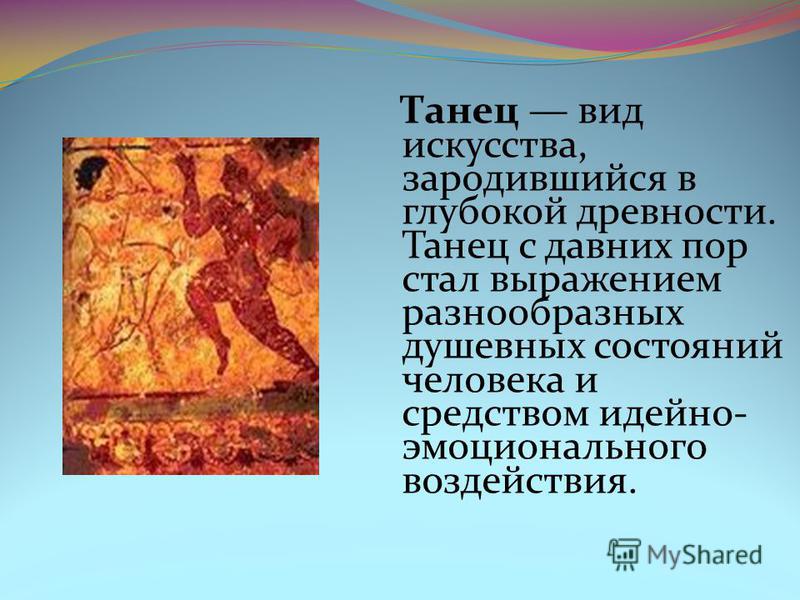
The dance expresses the nature of time, the spirit of the era. Each nation has its own dance traditions, choreographic language and plastic expressiveness. Therefore, dance music always bears the imprint of a national character and living conditions.
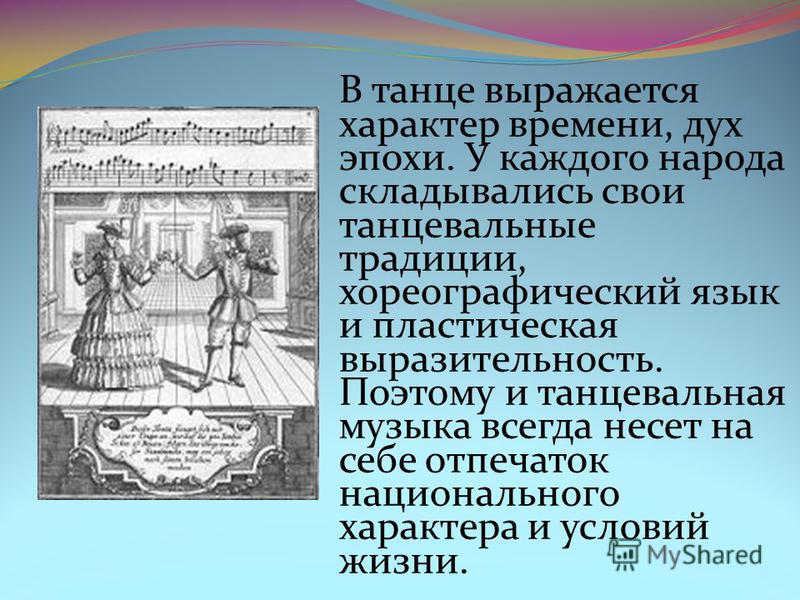


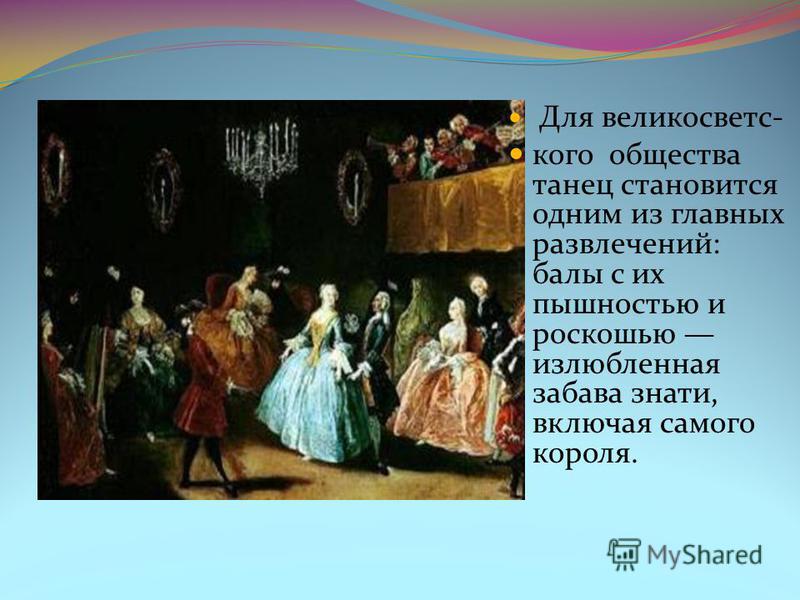
Minuet (French menuet, from the menu small) is an old folk French graceful dance, so named because of its small steps. Derived from the slow folk dance of the province of Poitou. It is written in a two-knee warehouse, in a three-share size (3/4). Since the mid-seventeenth century, ballroom dance, widespread throughout Europe
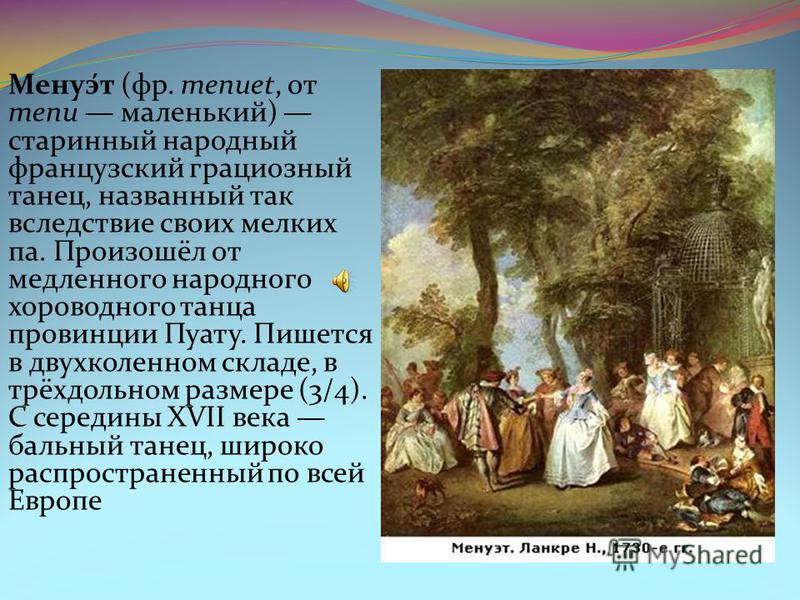
Allemanda (from French: allemande German) is one of the most popular instrumental dances of the Baroque era. Allemanda originated in the 16th century. Clock size: 2/4. The pace is average. This dance most likely came from dances popular at that time in Germany.
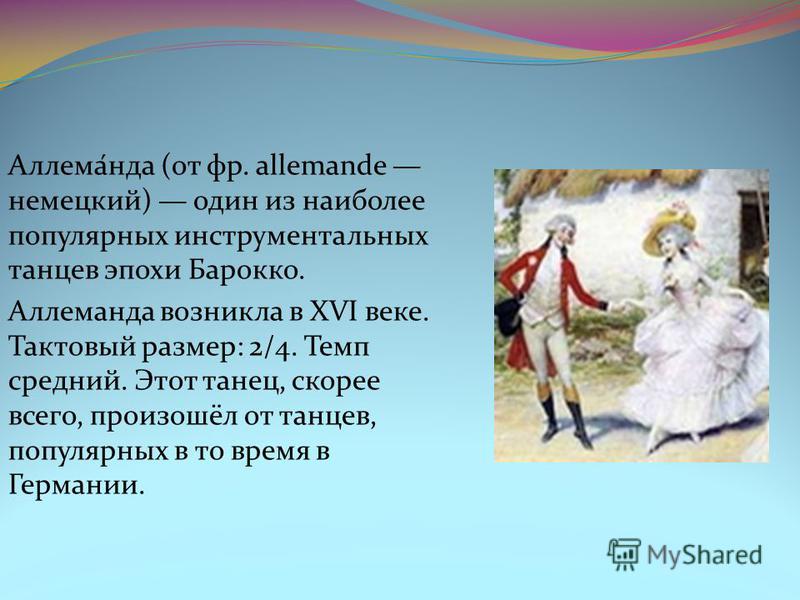
Courant (French courante, lit. running) is a court dance of Italian origin. Gained distribution at the turn of the XVI-XVII centuries. Initially, it had a musical size of 2/4, a dashed rhythm, they danced together with a slight jump while passing around the hall, the gentleman held the lady's hand.
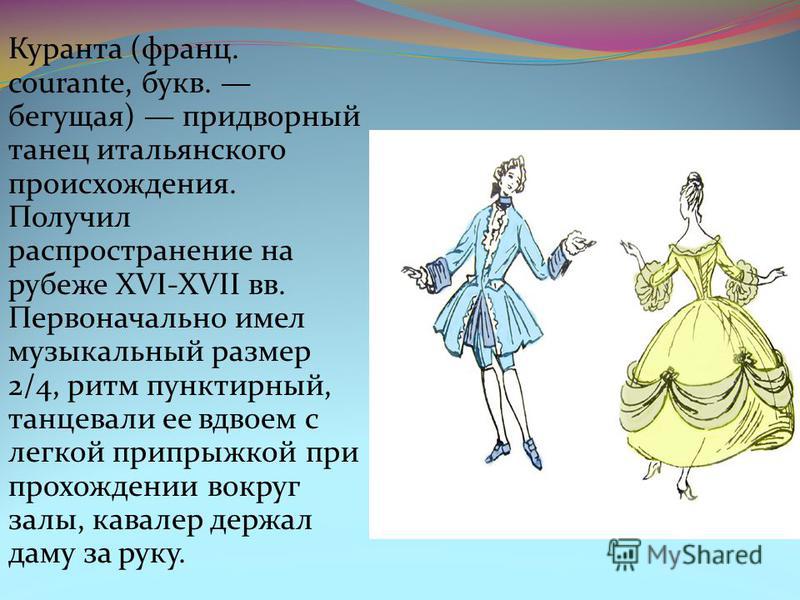
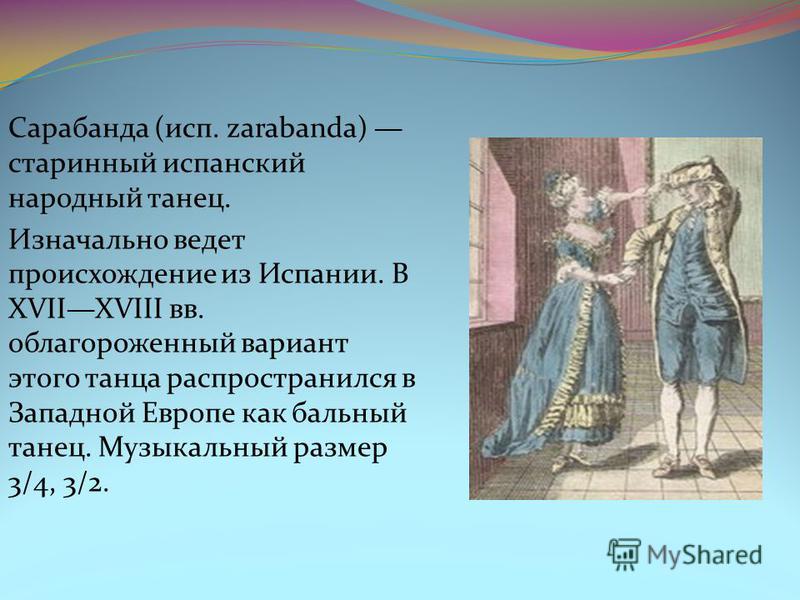
Gavotte (French: Gavotte Gavotte dance, inhabitants of the Auvergne region), an old French folk dance. The musical size is 4/4 or 2/2, the temperament is moderate, the onset is characteristic of the start. Gavotte’s music is light, elegant, sometimes with a pastoral, sometimes with a solemn shade. Known since the 16th century. In the 17th century became a court dance, graceful and often cutesy.
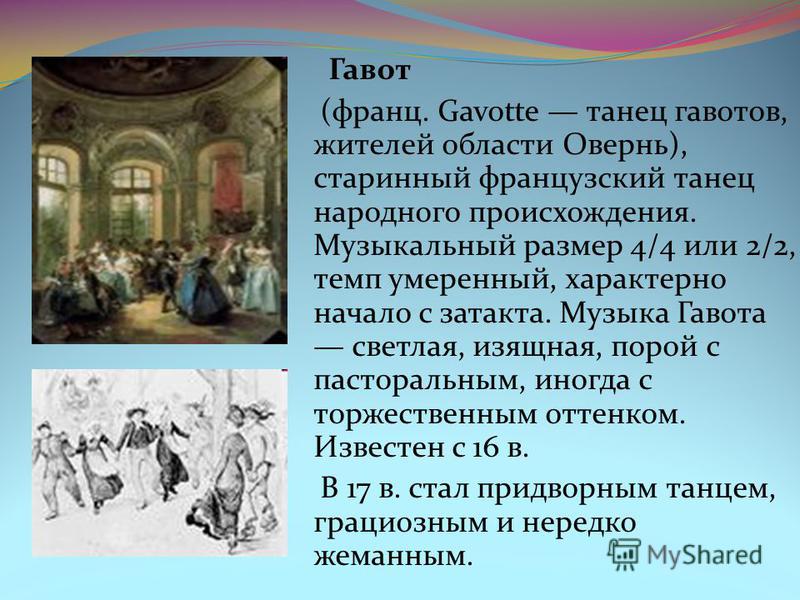
GIGA is a fast ancient folk dance of Celtic origin, still preserved in Ireland. In the British Isles, known since the 15th century. Initially, the jig was a pair dance; among sailors spread as a solo, very quick dance comic character.
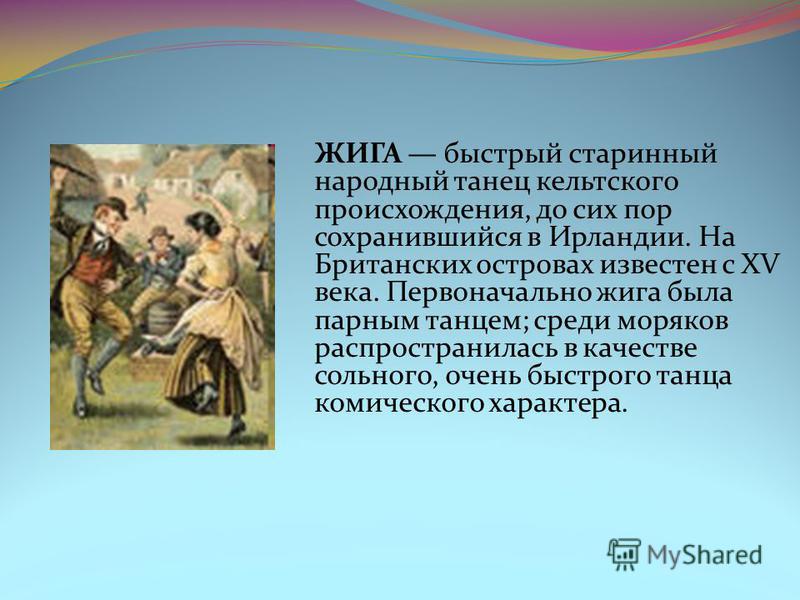

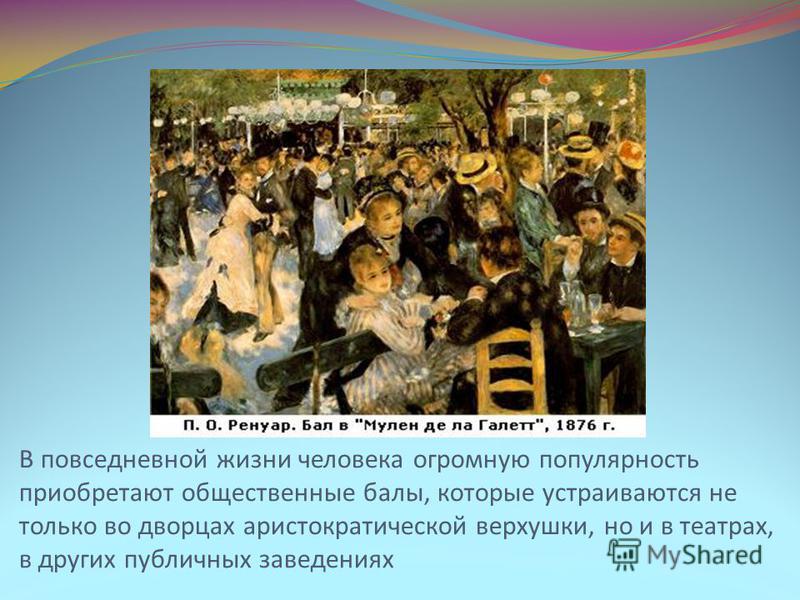
Mazurka - the name comes from the inhabitants of Mazovia Mazur, who first appeared this dance. Musical size 3/4 or 3/8, the tempo is fast. Frequent sharp accents shifted to the second, and sometimes to the third beat. In the XVII century, Mazurka entered the cycle of Polish peasant dances. In the 19th century, it spread as a ballroom dance in Europe.


Polonaise (from French polonais Polish) solemn dance procession at a moderate pace, having a Polish origin. It was performed, as a rule, at the beginning of balls, emphasizing the solemn, sublime character of the holiday. In the polonaise, dancing couples move according to the geometric shapes established by the rules. The musical size of the dance is 3/4.

Landler The general name for the slow Austro-Bavarian dances in the amount of 3/4. Landler melodies already existed in the 17th century. Landler can be considered the forerunner of the waltz, but it was performed more slowly and had a slightly different construction. Its options are Styeriche and Schuplattler (Tyrolean dance in wooden shoes).
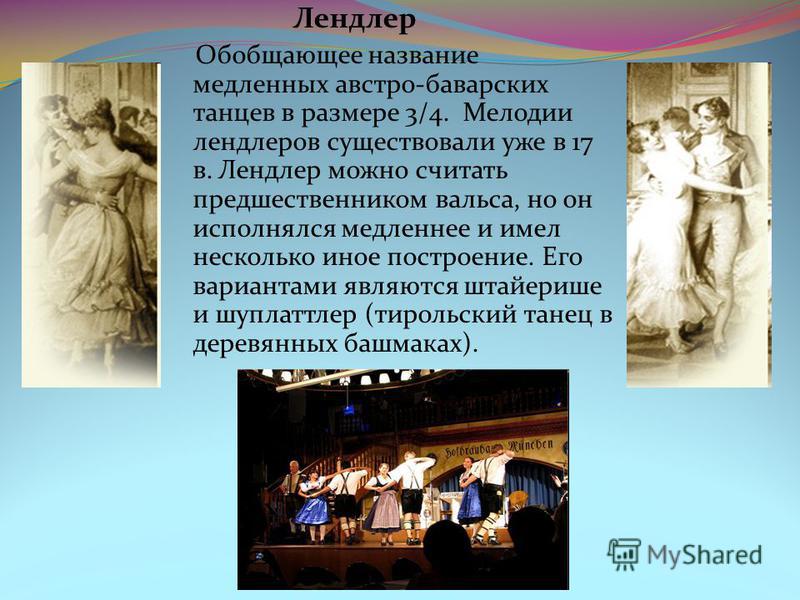
Polika (Czech folk dance) is a fast, lively Central European dance, as well as a genre of dance music. He appeared in the middle of the XIX century in Bohemia, and since then has become a famous folk dance. Polk was written by Johann Strauss I and his son Johann Strauss II. The musical size of the polka is 2/4 (two quarters).
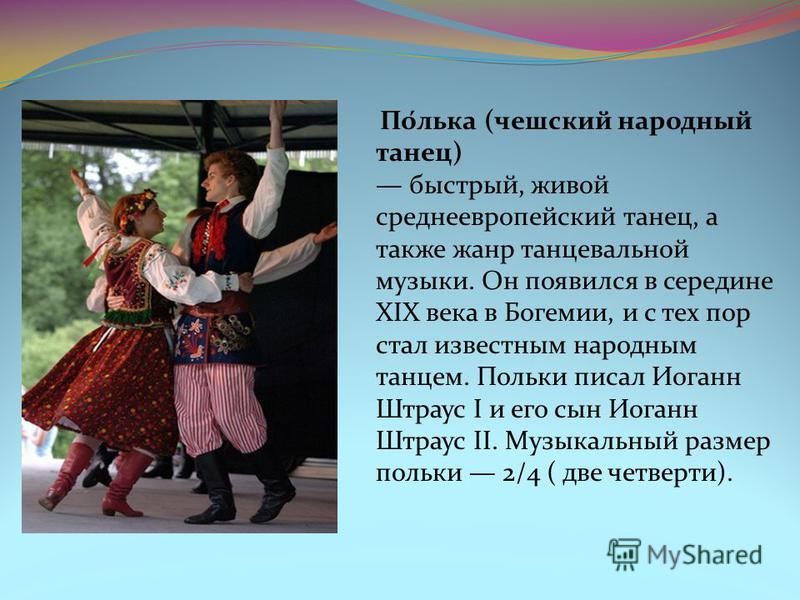



HABANERA (from the name of the city of La Habana Havana) Cuban dance and song. Size 2-lobular (2/4), the pace is moderate or moderately mobile. A distinctive feature is the constant rhythm accompaniment formula with a dashed rhythm on the 1st beat, sustained in bass throughout the play.

CHARDASH (from the Hungarian. Csarda tavern, zucchini) Hungarian folk dance in the amount of 2/4 or 4/4, with characteristic syncopations and typical melodic endings that are periodically repeated. It consists of two contrasting parts: a melancholy or pathetic introduction that accompanies a circular man’s, and a quick friska that accompanies an incendiary pair dance.


Charleston (English charleston named Charleston (USA), where he first appeared) is an American improvisational dance that was widely used in the early 20 century .; characterized by rapid turns of the foot of one or both legs with socks inward, accompanied by simultaneous short and rhythmic squats; muses size - 4/4; pace from moderately fast to fast.

TANGO - dance and song genre. The musical size is 4/8, 4/4, 2/4, the tempo is moderate or moderately mobile, the rhythm is active, accented, saturated with syncopes and a dotted line. First of all, tango is known as a pair ballroom dance, in the history of which there are three successive stages: 1) Andalusian tango, 2) Creole tango, 3) Argentine tango.



BOSSA-NOVA BOSSA-NOVA (from Portuguese. New hobby) pair dance of South American descent, who came to the dance halls of Europe and America around 1960. The dance evolved from Brazilian music under the influence of jazz in a completely new rhythm (new beat). It is characterized by a sliding drawn step in place or in moving around the hall. For musical accompaniment, typical sizes are 2/2, 4/4, a rhythm with sharp syncops and a variety of accents.

The origin of the name “bossa nova” (literally bossa “bump”, “knoll”, “hump”; nova “new”) is associated with the Brazilian slang term “bossa”, fashionable in the late 1950s, which meant roughly the same as Russian the word "chip": a feature, a striking feature.
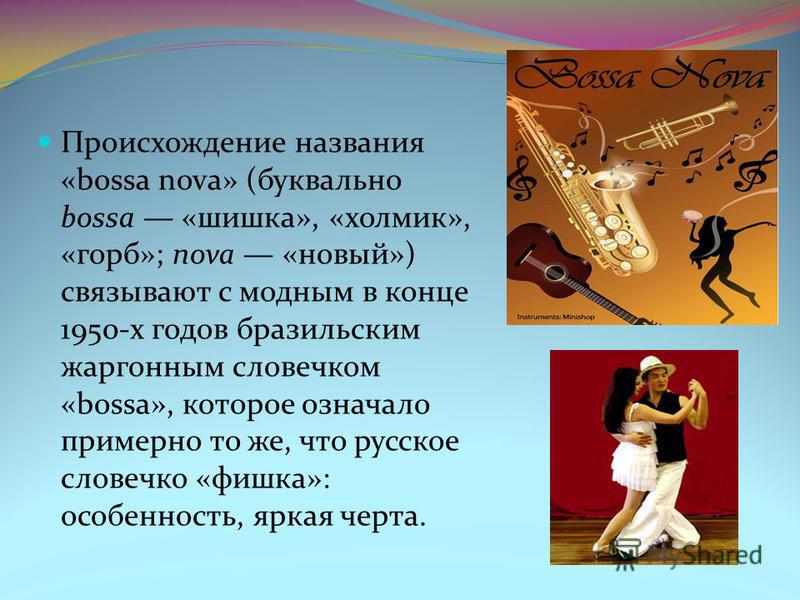
Bossa nova appeared in Rio de Janeiro, in the Ipanema area, the habitat of wealthy people. Initially, the bossa nova was a mixture of traditional rhythms of Brazilian samba and classical American jazz, performed at parties and home concerts for an educated audience. Soon, however, the bossa nova ceased to be only “music for the elite” and sounded in clubs, art cafes and just on the streets of Brazilian cities.
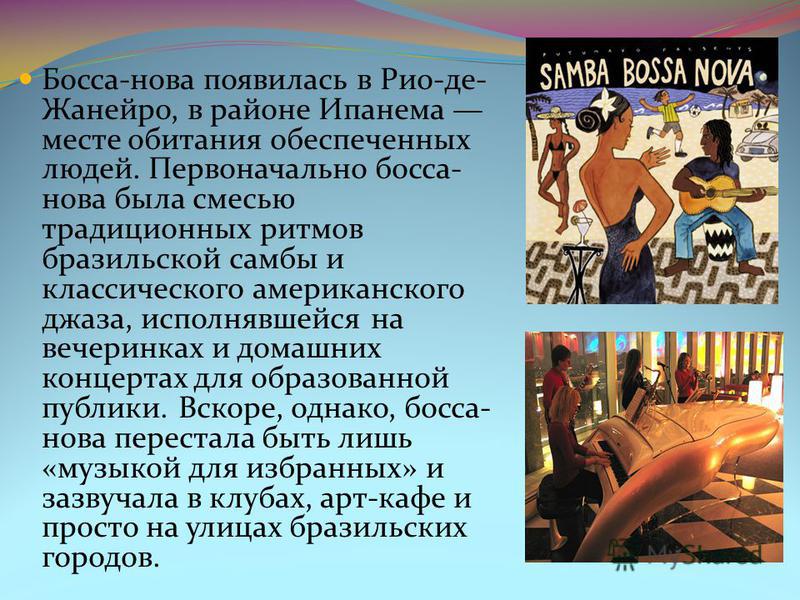
Brakedance. This is a dance that belongs to the hip-hop culture, and inside it is called "breaking" (breaking, English breaking). In the late sixties, early seventies, people appeared who began to move in a peculiar way to the music. So a dance was born in which falling to the ground was combined with elements of rotation.

Hip-hop (English hip hop) cultural direction that originated among the working class of New York in the 1970s. Hip-hop has become a part of youth culture in many countries of the world. Hip-hop music consists of two main elements: rap (rhythmic recitative with clearly defined rhymes) and the rhythm set by the DJ.
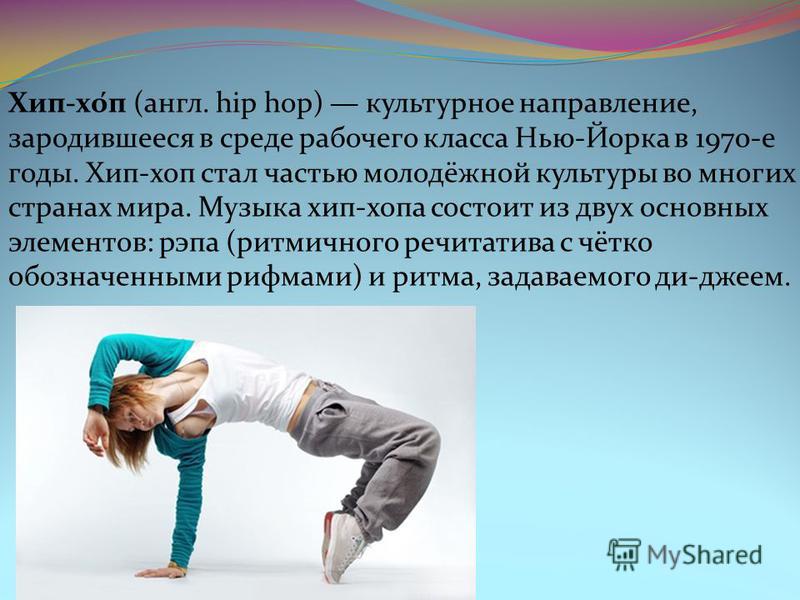
Oh dance! You are the dreams of my aspiration. There is nothing more beautiful in the world, Than the triumph of love and inspiration, Ovation is a delightful bouquet! Foxtrot and tango, jive and tarantella, King of all dances, old, good waltz. And the enchanting power of music Carries and circles you in a star whirlwind! Here is a riot of colors, tender feelings of an instant, Hands flashing, hips, legs moving ... Oh, dance! You are a great creation, Exciting, divine delight!

Dance art. Types of dancing.
Tanec - This is the art of movement, and movement can be very different. But when this movement spiritualizes, affects the viewer, with the goal of changing his spiritual being, this is already art.
Dance (Polish taniec, from German Tanz) is a form of art in which the main means of creating an artistic image is the movement and position of the dancer's body.
In dance, emotional experiences are transmitted by means of plastic movements and rhythmically clear and continuous changes in the expressive positions of the human body.
Dance art originates in ancient times. The rare dance ancient Greeks interpreted the dance as a wonderful gift from the gods. There were warlike dances, cult dances, public festivals and theatrical dances, dances in everyday life.
For all nations, dance is an expression of inner feelings; through various poses, leaps, movements, joy, grief, love or anger are expressed. In the dance you can even show fantasies, disappointments and hopes.
All human emotions manifest themselves through movement. Try to convey your joy or anger in a word, without moving a single muscle in your face or body. You won’t succeed! It will be difficult to really understand - are you happy or sad? ..
The word "dance" in Russian comes from the German "Tanz". But since it was borrowed from the Polish language, the suffix "-etz" was added to it. The word dance came into the Russian language only in the 17th century. Until then, the common Slavic word "dance" was used. Since the end of the XIX century. the words "dance" and "dance" began to be used as synonyms. However, the concept of "dance" was broader than the concept of "dance". In the modern version, the opposite is true. The word "dance" is more often used in relation to folk dancesthan to ballroom and other forms of dance art.
There is everything in dance. In the classics - nobility, grace, restraint. This is so useful to you at receptions and presentations. In fast dancing - dynamics, rhythm, many variations. This will become your inner rhythm, which will help to cope with the problems of modern life. In oriental dances, philosophy, wisdom, dignity and gentleness are concluded
The main characteristics of the dance are rhythm (fast or slow repetition and variation of movements), drawing (combination of movements in the composition), dynamics (range of movements), technique (degree of body possession and mastery of performance).
Dance gives you what you invest in it. This is your fun, hobby, distraction from life, and you will not find deeper meanings in the dance unless you stop treating it as a thoughtless movement; stop - and the dance turns into a mirror and gives you a reflection of your personality traits, your personal problems (which you try not to think about in everyday life), will give you the opportunity to resolve them.
Dance, like any kind of physical activity, necessarily brings results if you engage in regularly and intensively. Moreover, he takes on the body in a complex way, in contrast to training in the gym. The beginner's training level (with the exception of the lower break) can be any, as well as age. Due to the harmonious development of all muscles, the dance will provide you with body grace, strength and endurance, align your back, teach you how to move easily, clearly and beautifully.
Today it is fashionable not only to attend parties, but also to hone the skills of movements in dance studios. And with the most diverse styles and difficulty levels. Movies, stage shows, and music videos with impressive dance numbers add to the popularity of dancing.
Dance is an art, and its styles carry the culture of many centuries. In addition to the magnificent movement, the dance has a history, legends, costumes - everything that forms its aesthetics, which alone, separately from everything else, attracts people to itself. When you dance, you feel involved in the great cultural heritage.
Types of dancing can be divided into the following categories:
Classical dance: ballet
West European Ballroom Dancing
Historical dance
Club dancing
Latin American Program ballroom dancing
Folk dance
A wedding dance
Social dancing
Dance Sport
Twentieth Century Dancing: Contemporary Dance
Dance-motor therapy
Classical dance
The system of expressive means of choreographic art, based on the development of various groups of movements and positions of the legs, arms, body, head. As a plastic speech, classical dance incorporated the movements of various folk dances and pantomime actions, many movements and poses of the human body. European classical dance was formed in the XVI-XVII centuries.
The usual idea of \u200b\u200bclassical dance is associated with the external, traditional appearance of a ballerina: in a white tutu, tights and pointe shoes with a strong toe that allows you to dance “on your fingers”.
An obligatory principle of classical dance is eversion - the basis of the starting points and poses. In the classical dance, five positions of the legs and three positions of the hands are approved, the positions of the body, head, shoulders, and the shape of the poses are strictly established: en face (en face), croise (croise), efface (efface), ecarte (ecarte), i.e. the main, simultaneous turns of the body, legs and arms in relation to the audience, as well as the development of outward movements: en dehors (en deor) and inward: en dedans (en dedan).
The classical dance system has developed clear groups of movements: bend and squat - plie (plie), pull - tendre (tandra), lift - relever (relev), slide - glisser (glide), jump - sauter (sauté), throw - elanser (elance) ), turn - tourner.
The basics of classical dance will allow you to improve your movements, plastic and stretching.
Ballet - (French. ballet, from Italian. balletto - dance), a form of stage musical and theatrical art, the contents of which are revealed through dance. As court-aristocratic art began to take shape in Europe in the 16th century. from dance scenes performed at carnivals and festivals. (The term “ballet" appeared in Renaissance Italy and meant not a performance, but a dance episode). Gradually, such scenes turned into independent dance performances. Ballet can be plot (classical, dramatic) and plotless (ballet symphony, miniature).
XVIII century - the time of the great J.J. Noverra, choreographer of the French, Russian and Austrian courts. He creates ballet in the form in which it continues to exist in our days. Noverre composed serious ballets, trying to preserve in writing all the choreographic steps. At this time, the original ballet terminology is taking shape.
The beginning of ballets in Russia dates back to the Petrine era. During the reign of Anna Ioannovna, several foreign choreographers appeared in St. Petersburg, bringing on Russian soil the achievements of ballet art, which was significantly successful in Europe, especially in Paris. In Russia, ballet spreads in the XVIII century. The term "classical ballet" appeared in Russia in the 50-60s of the XIX century.
In the XIX - XX centuries. in the art of ballet, no country can compare with Russia. In the XIX century. the highest achievements of ballet are associated with choreographers Sh.L. Didlo, M.I. Petipa and L.I. Ivanov. The Russian Seasons Abroad, organized by S.P. Diaghilev. Among the most famous Russian masters: choreographers K.Ya. Goleizovsky, F.V. Lopukhov, R.V. Zakharov, Yu.N. Grigorovich; artists G.S. Ulanova, M.M. Plisetskaya, M.T. Semenova, O.V. Lepeshinskaya, V.M. Chabukiani, A.M. Messerer, N.M. Dudinskaya, V.V. Vasiliev, E.S. Maksimova, N.I. Bessmertnova, M.-R.E. Liepa, R.Kh. Nuriev, M.N. Baryshnikov et al.
Distinctive features of ballet, recognizable even with the naked eye, are eversion, characteristic settings of the legs, body, arms (see positions) and pointe shoes that allow you to stand on your fingers.
In modern ballet, along with classical elements, the movements of jazz, art nouveau, gymnastics and acrobatics are widely used. Used appropriately and tactfully, they greatly enrich ancient art.
Folk dances
It is safe to say that this is the most common form of dance art. There is not a single nationality, no matter how small it may be, which would not have a dance culture inherent only to it. Dances and songs of various nationalities arose from folk games and entertainment related to work processes, religious rites and family holidays.
Folk art is the basis on which professional art is created and developed, the source from which movements, figures, and often well-established dance compositions were drawn. Dances deprived of a folk basis were short-lived and were soon forgotten.
Of course, the dance art of some countries is popular only within their borders, while others have conquered the whole world. It is unlikely that there will be an indifferent spectator of the flamenco dance (the national dance of the Spanish gypsies), Russian, Moldavian, Georgian, Indian, Celtic and other folk dances.
In Slavic dances - from the Balkans to Russia, despite the differences in languages, culture, lifestyle, there are a lot of common features: arm circles, boardwalks, a collar ... The figures of old Russian round dances and no less old French farandola are very similar in many respects. Elements of Spanish, Gypsy and Andalusian dances in many ways resemble the steps of the Irish jig. Volta, the forerunner of the waltz, is a French dance, but steps with the ladies turning in pairs appeared in several countries at the same time and immediately gained popularity. The original folk dance of many countries is a round dance. Ancient round dance dances continue to live in many corners of the globe, and every nation makes changes in the performance of round dance - national culture and temperament.
Interestingly, the climate played an important role in the development of dance. If you are going to frost in a clearing, what will you do? Right, trample on. And move fast. Therefore, Russians, Irish, and other Slavic peoples have characteristic dances with drowning and leaps. (There are also fractions in Spanish dances, but there are no such jumps). In the cold, of course, you can move slowly, but only dressed very warmly. Warm and accordingly heavy clothes give rise to round dances. The colder the climate, the warmer and heavier the clothes, and therefore the slower the dance. So, our Russian dance is significantly different in the north and south. In the north they are more “important”, in the south they move more easily and fervently. Various objects and accessories also form certain movements, which are then executed without the given object in the hands. For example, the trajectories of a dance with a fan can be traced in the dances of peoples using a fan (Spanish, Japanese, etc.) and when this fan is not in hand.
A huge role is played by traditions, including those related to religion. In Islamic countries, women wear headscarves, burqas, so in the dance we see the shawl and shawls covering the face and head.
In addition to the internal factors affecting the formation of folk dance, there are also external ones - the influence of other national cultures. Simple neighborhood or trade relations result in some cultural interaction. If one country is under prolonged oppression of another, then some mixing of cultures cannot be avoided.
Folk dance in Russia is popular largely thanks to the leading dance ensembles. Their performance of the most complicated patterns, drawings and tricks led to the creation of a direction, which many choreographers call the “advanced” folk dance, which is already different from its origins.
Latin American Ballroom Dance Program
Latin America has provided the world with a whole feast of dances arising from the mixing of several cultures - African, Spanish, Portuguese, American.
There are five of them in the international program of sports ballroom dancing: samba (expansive and incendiary dance), cha-cha-cha (flirty and cheerful), rumba (romantic and sensual), paso doble (tense and tragic, representing bullfighting) and jive (carefree and energetic )
Four Latin American dances (except for the Paso doble, which is the Spanish-French dance) originated between Cuba, the United States and South America and developed under the influence of European and Negro folklore. All figures of the five dances were standardized by international dance federations, there is a single technique, rhythm and pace of performance of these dances. Therefore, the steps of samba, rumba, cha-cha-cha are performed the same way around the world. The basic technique of Latin American competitive dances was first streamlined and recorded by Walter Laird.
Antillean dances (salsa, merengue, mambo) came out of the same geographical zone, they are designed in the spirit of the Afro-Cuban tradition of music. In Europe, they appeared later, in the middle of the twentieth century. The film "Dirty Dancing" (1987) aroused great interest in Antillean and Latin American dances. The popularity of Latin American music and culture has reached global proportions. Incendiary Brazilian and Cuban music sounded in clubs and discos, bright Hawaiian shirts and skirts with ruffles were streaked. Many club pair dances do not require complex equipment - they are easy to learn, and the main thing in them is not to be indifferent, but to express your mood, feelings and emotions.
All these dances are characterized by rhythmic music, and they require excellent perception of pace. Latin American dances are distinguished by a peculiar plasticity of movements. Unlike West European dances (see West European dances), Latin American partners are not in constant contact. They are more independent and free for improvisation, especially on the part of a partner who emphasizes her beauty, elegance and grace in every possible way.
So five dances come in Latin American Program ballroom dancing: Samba, Cha-cha-cha, Rumba, Paso doble, Jive.


